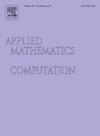Evolutionary multigame with perception competition between conformists and imitators
IF 3.4
2区 数学
Q1 MATHEMATICS, APPLIED
引用次数: 0
Abstract
Perceptual heterogeneity reflects individuals’ different perspectives on the same thing, and competition among individuals with different perceptions of either social dilemmas or payoffs can independently promote cooperation. In this article, we construct a coupled competition mechanism to explore the impact of competition between the two types of perceptions. Specifically, individuals’ differing perceptions of social dilemmas are modeled by the snowdrift game () and the prisoner’s dilemma game (), differing perceptions of payoffs are captured by conformists and imitators. Extensive simulations show that the coupled competition mechanism markedly promotes cooperation. players are substantially less competitive than players, which dominate the population. Conformists act as an amplifier, inclined to choose cooperation when cooperators are dominant, thus further promoting cooperation levels. When defectors are dominant, conformists may temporarily choose to defect in the short term, but defection is unsustainable due to lower average accumulated payoffs. We further find that intensified competition among imitators weakens the competitiveness of conformists and diminishes their positive impact on cooperation. Finally, we demonstrate the impact of different proportions of conformists, network structures, and noise levels on the main results to verify the robustness of the model.
随大流者和模仿者之间感知竞争的进化多博弈
感知异质性反映了个体对同一事物的不同看法,对社会困境或回报有不同看法的个体之间的竞争可以独立地促进合作。在本文中,我们构建了一个耦合竞争机制来探讨两种认知之间竞争的影响。具体而言,个体对社会困境的不同感知是由雪花漂移游戏(SDG)和囚徒困境游戏(PDG)模拟的,对收益的不同感知是由随大流者和模仿者捕获的。大量的模拟表明,耦合竞争机制显著促进了合作。与SDG玩家相比,PDG玩家的竞争力更弱。从众者扮演着放大器的角色,当合作者处于优势地位时,从众者倾向于选择合作,从而进一步提升合作水平。当叛逃者占主导地位时,从众者可能会在短期内暂时选择叛逃,但由于平均累积收益较低,叛逃是不可持续的。我们进一步发现,模仿者之间激烈的竞争削弱了墨守成规者的竞争力,降低了他们对合作的积极影响。最后,我们展示了不同比例的从众者、网络结构和噪声水平对主要结果的影响,以验证模型的鲁棒性。
本文章由计算机程序翻译,如有差异,请以英文原文为准。
求助全文
约1分钟内获得全文
求助全文
来源期刊
CiteScore
7.90
自引率
10.00%
发文量
755
审稿时长
36 days
期刊介绍:
Applied Mathematics and Computation addresses work at the interface between applied mathematics, numerical computation, and applications of systems – oriented ideas to the physical, biological, social, and behavioral sciences, and emphasizes papers of a computational nature focusing on new algorithms, their analysis and numerical results.
In addition to presenting research papers, Applied Mathematics and Computation publishes review articles and single–topics issues.

 求助内容:
求助内容: 应助结果提醒方式:
应助结果提醒方式:


